Physical Address
304 North Cardinal St.
Dorchester Center, MA 02124
The frontal sinus is protected by thick cortical bone. High-velocity impacts can result in frontal sinus fracture and brain injury. These complex injuries pose many surgical challenges and can be associated with long-term sequelae such as mucocele and meningitis. Optimal management strategies remain controversial. Treatment goals should include protection of the intracranial contents, avoidance of short- and long-term complications, restoration of an aesthetic frontal contour, and maintenance of sinus function when possible. A treatment algorithm is presented based on injury to three anatomic regions: the anterior table, the frontal recess, and the posterior table/dura.
Although not present at birth, the frontal sinus aerates by extension of the ethmoid air cells into the frontal bone. This process usually begins at 2 years of age and the sinus is completely developed by about the age of 15 ( Fig. 1.7.1 ). The degree of frontal sinus development is variable, with up to 11% of people having only a unilateral frontal sinus and 4% of people having no frontal sinuses at all. The anterior table bone averages 4 mm in thickness; while the posterior table is thinner, providing less protection to the anterior cranial fossa ( Fig. 1.7.2 ). The intersinus septum often divides the frontal sinus into two sides, each of which drains into their respective frontal sinus outflow tract. The frontal sinus drainage pathway has an hourglass shape ( Fig. 1.7.3 ), with the infundibulum above, true ostia in the middle (1–3 mm), and frontal recess below.
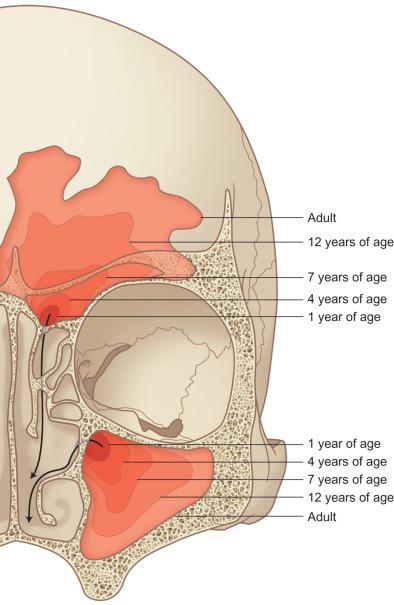
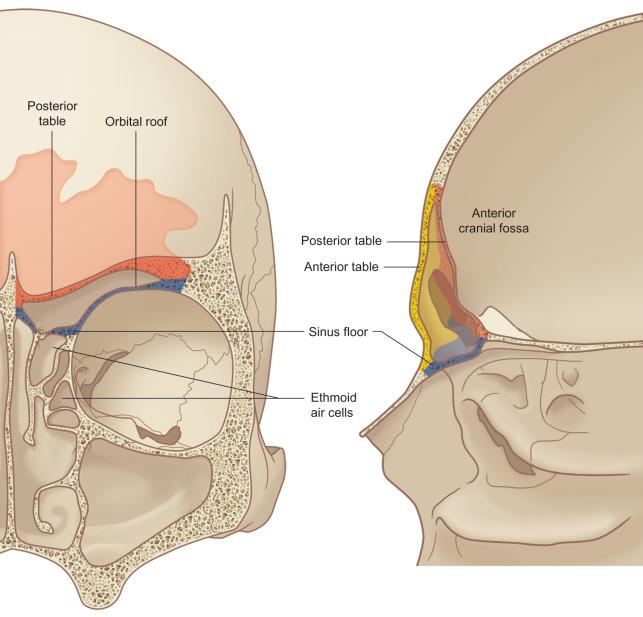
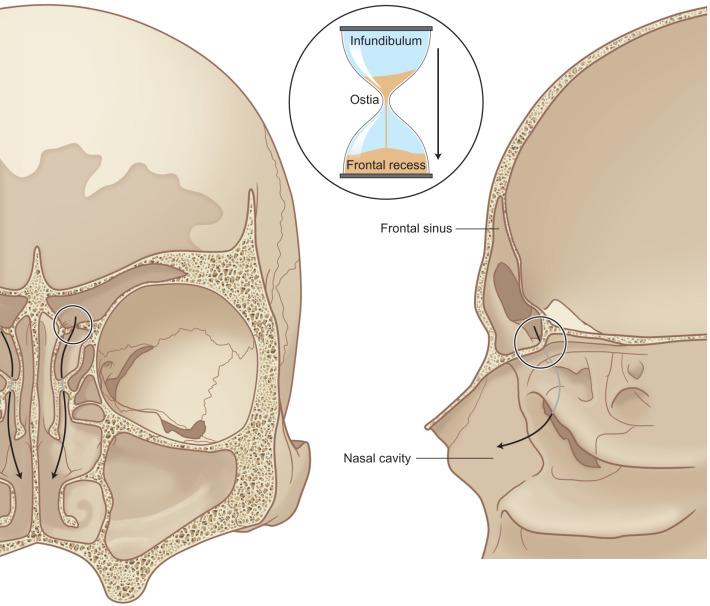
Frontal sinus fractures comprise approximately 5%–15% of maxillofacial injuries. The force required to fracture the frontal bone is greater than for any other facial bone. Improvements in vehicle safety, such as seatbelts and airbags, have significantly decreased the incidence of frontal sinus fractures. The majority of patients are young males (average 30 years) who sustain high-velocity injuries such as: motor vehicle collisions (52%), interpersonal violence (26%), and recreation or industrial accidents (14%). One-third of these injuries are isolated anterior table fractures; two-thirds involve some combination of the anterior and posterior tables as well as the nasofrontal recess; while isolated posterior table fractures remain quite rare (<2%). The majority of patients (75%) who sustain frontal sinus injuries will have associated craniofacial fractures.
Due to the high velocity nature of these injuries, the initial evaluation should focus on airway control and hemodynamic stability. A complete head and neck examination should rule out injury to the brain, spine, orbits, and facial skeleton; including the frontal sinus. Patients with frontal sinus fractures often complain of forehead pain and swelling. Physical findings may include paresthesias, epistaxis, diplopia, forehead abrasions, lacerations, and hematoma.
Fractures of the posterior table place patients at increased risk of dural tear, cerebrospinal fluid (CSF) rhinorrhea, and meningitis. The most common clinical presentation of CSF rhinorrhea is intermittent bloodstained, or clear watery anterior nasal discharge, salty postnasal drainage, and headache. If rhinorrhea is present, it can be evaluated with a “halo test,” whereby the fluid is allowed to drop onto filter paper. If CSF is present, it will diffuse faster than blood and result in a clear halo around the blood. A more definitive diagnosis can be made using a beta-2 transferrin assay. With its high sensitivity (99%) and specificity (97%), this biochemical assay is viewed as the gold standard for diagnosis of CSF rhinorrhea. Disadvantages of the test include: expense, labor-intensive fluid collection, and waiting period for results (approximately 3–5 days).
The gold standard radiographic examination for traumatic injuries of the facial skeleton is a thin cut (≤1 mm) computed tomography (CT) scan. To help improve diagnostic accuracy, these images should be reformatted into coronal, sagittal, and 3-dimensional reconstructions. The axial images are preferred for evaluation of the anterior and posterior table ( Fig. 1.7.4 ); sagittal images for the frontal sinus outflow tract and skull base ( Fig. 1.7.5 ); and the coronal images for the orbital roof/sinus floor ( Fig. 1.7.6 ). Three-dimensional reconstructions ( Fig. 1.7.7 ) offer a comprehensive view of the injury. They are helpful to assist in surgical planning, facilitate patient education, and delineate the size/location of bone fragments, which can reduce the need for soft tissue dissection.
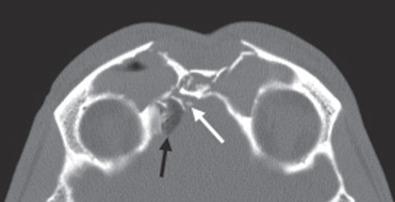
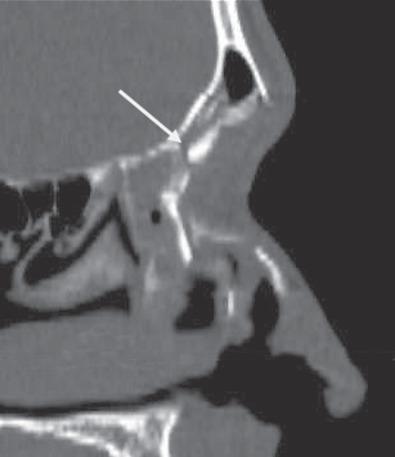
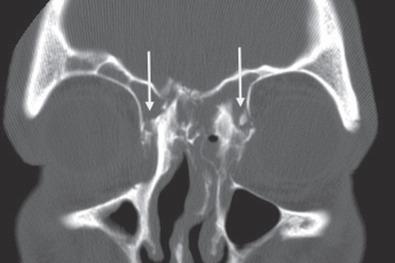
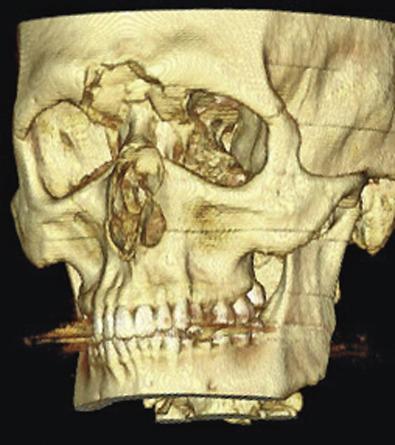
The major surgical approaches to the frontal sinus include: laceration, trephination, percutaneous, endoscopic brow, direct forehead/suprabrow, upper blepharoplasty, endonasal sinusotomy, and coronal.
When lacerations are present, they should be used to assist with fracture visualization/reduction as well as hardware placement. While lacerations can be extended for greater access, caution should be used. This may result in more pronounced facial scaring and paresthesias. Small fractures can be treated through lacerations alone. But the actual exposure requirements necessary to complete the repair can only be assessed intraoperatively. Therefore, consent for other surgical approaches should always be obtained.
Frontal sinus trephination is a technique that offers added visualization and access to the frontal sinus. A 1.0–1.5 cm curved skin incision midway between the medial canthus and glabella is made just inferior to the brow ( Fig. 1.7.8 ). Incisions within the brow itself are not recommended due to the risk of alopecia and injury to the supratrochlear/supraorbital neurovascular bundles. To reduce the risk of visible scar formation or webbing, a “V” can be inserted to break up the incision line. Careful dissection down to the frontal bone is performed with a guarded needle tip electrocautery. The frontal sinus location is confirmed with a CT scan or the use of intraoperative navigation. A small cutting bur is used to create a 4–5 mm frontal sinusotomy ( Fig. 1.7.9 ), the mucosa is opened, and a 30 degree endoscope is used to visualize the sinus. A Valsalva maneuver can be performed to better localize a CSF leak. If more lateral visualization is required, a flexible pediatric bronchoscope can be used.
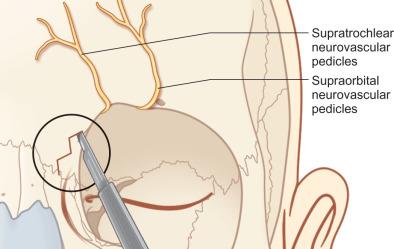
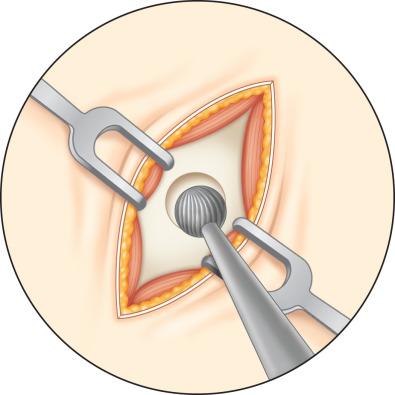
Several authors have described case reports or small case series of percutaneous fracture reduction for primary repair. This involves stab incisions to visualize the bone segments, and percutaneous screws for fracture reduction.
Endoscopic brow approaches, while developed for brow-lifting procedures, have been adapted for primary and secondary repair of anterior table frontal bone fractures. Using brow-lift instrumentation, a 3–5-cm parasagittal “working” incision ( Fig. 1.7.10 ) is placed 3 cm posterior to the hairline directly above the fracture. Limited use of electrocautery will reduce the risk of alopecia. The incision is taken down to bone and a brow-lift elevator is used for subperiosteal dissection to the level of the fracture. Through a second 1–2-cm “endoscope” incision (placed approximately 6 cm medial to the working incision), a 4 mm 30 degree endoscope within a rigid endosheath is introduced for visualization. A large guard on the endosheath will help with tissue elevation and maintenance of the optical cavity. Careful subperiosteal dissection ( Fig. 1.7.11 ) is performed over the fracture deformity under endoscopic visualization, with care to identify and preserve the supraorbital and supratrochlear neurovascular bundles.
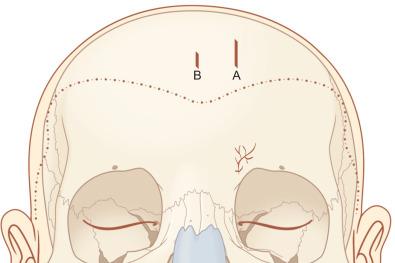
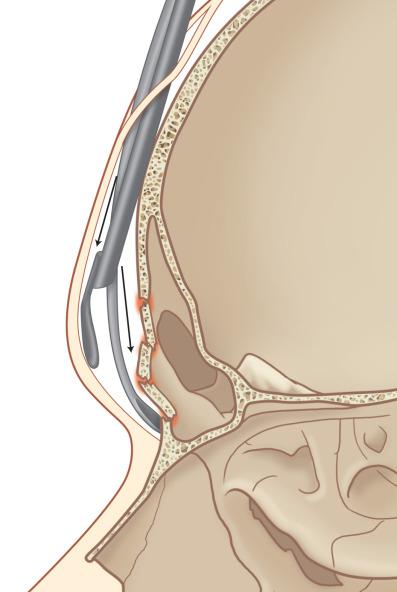
Large lacerations can provide adequate access for open reduction and internal fixation of some fractures. Significant extension of such lacerations should be avoided for aesthetic reasons. However, a direct approach, whereby an incision is placed within a horizontal rhytid over the fracture, is effective in patients with deep rhytids. Direct transcutaneous supra- and infrabrow incisions have also been described. Paresthesias related to these approaches resolve in most patients, however the authors believe that incisions placed directly above the brow have a higher risk of long-term paresthesias and visible scarring.
Become a Clinical Tree membership for Full access and enjoy Unlimited articles
If you are a member. Log in here